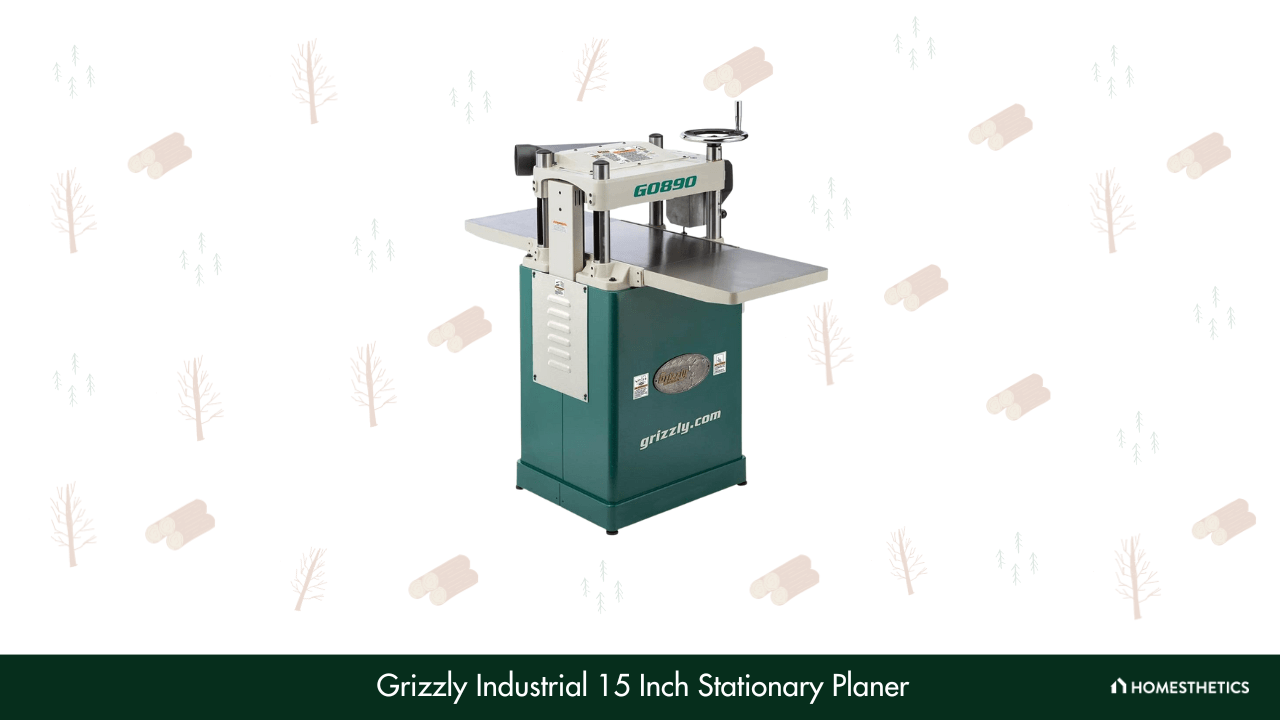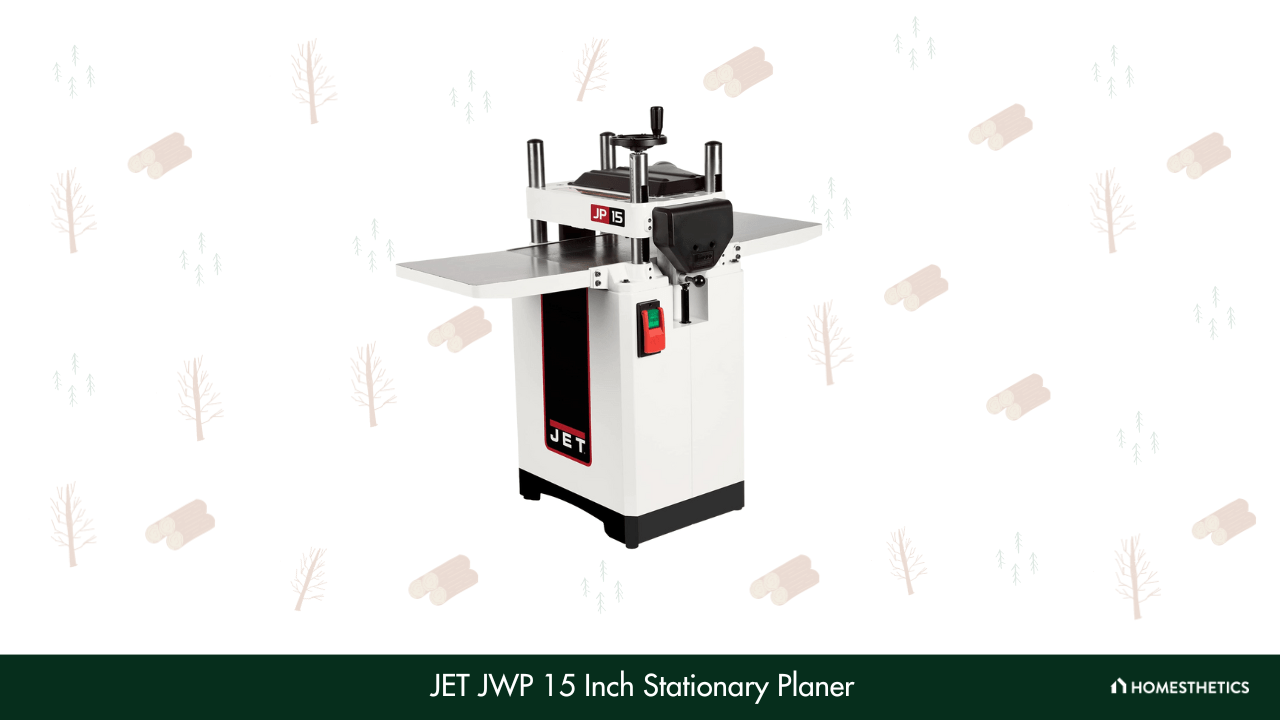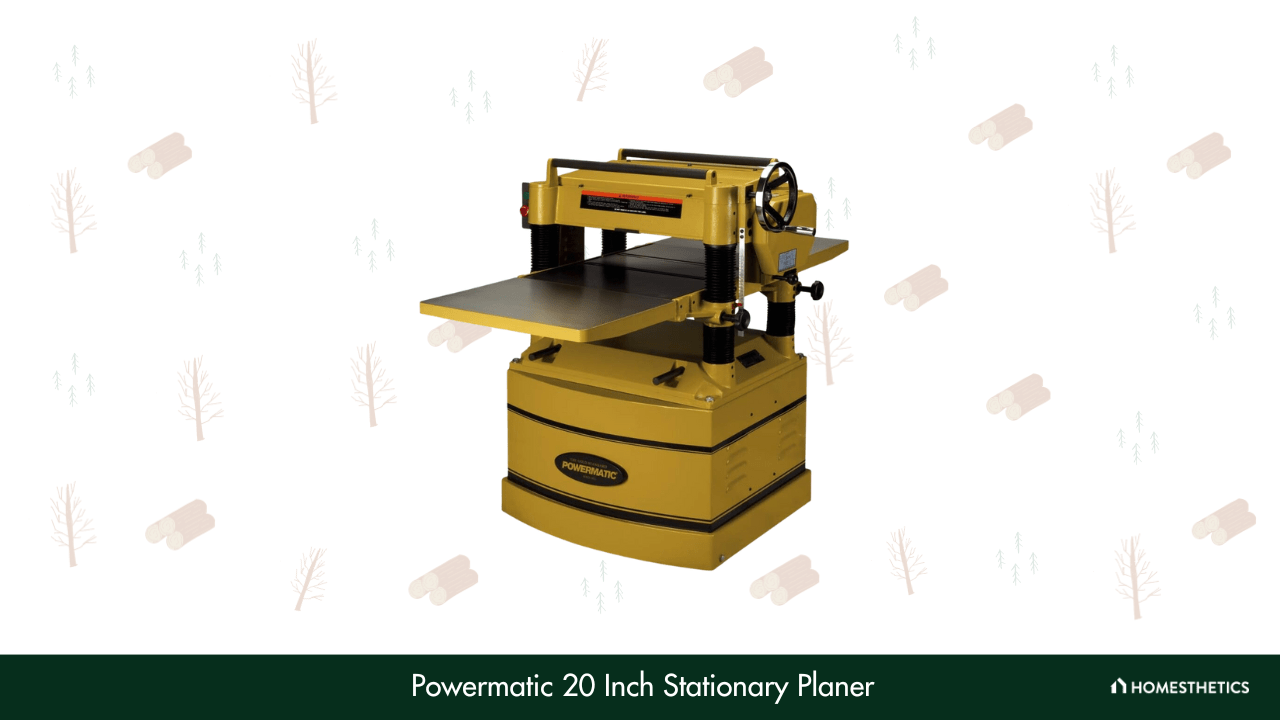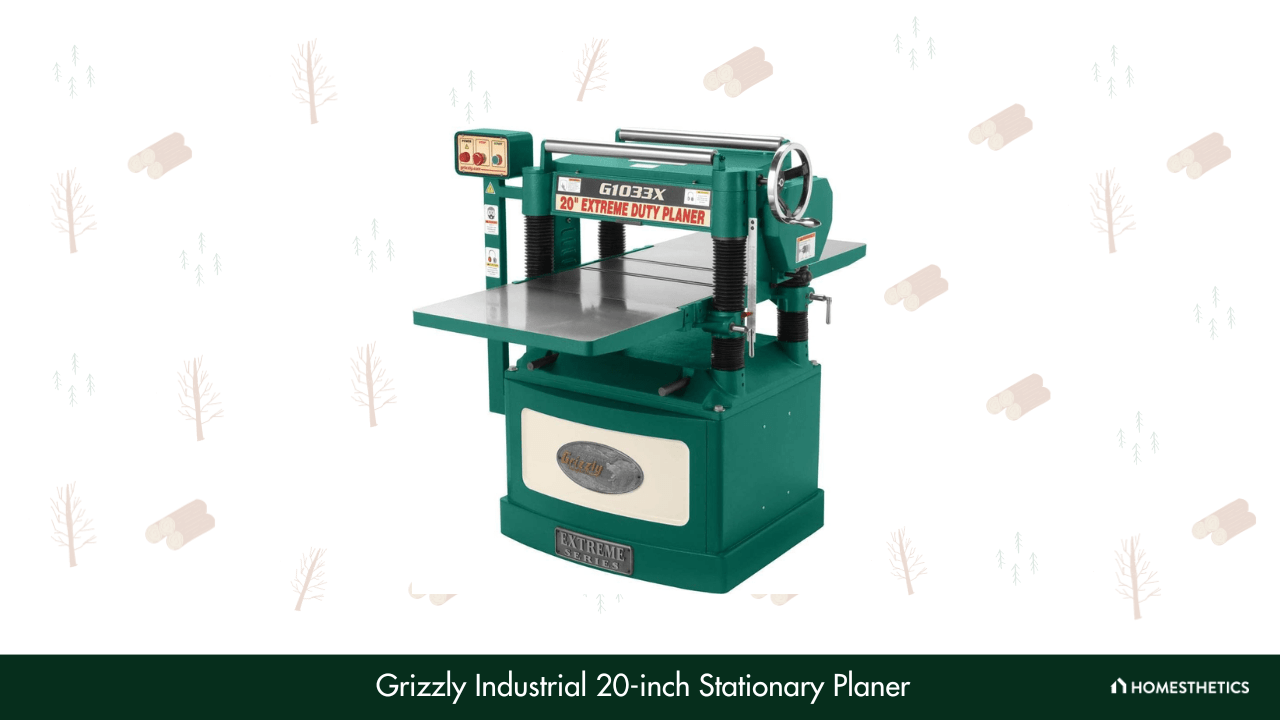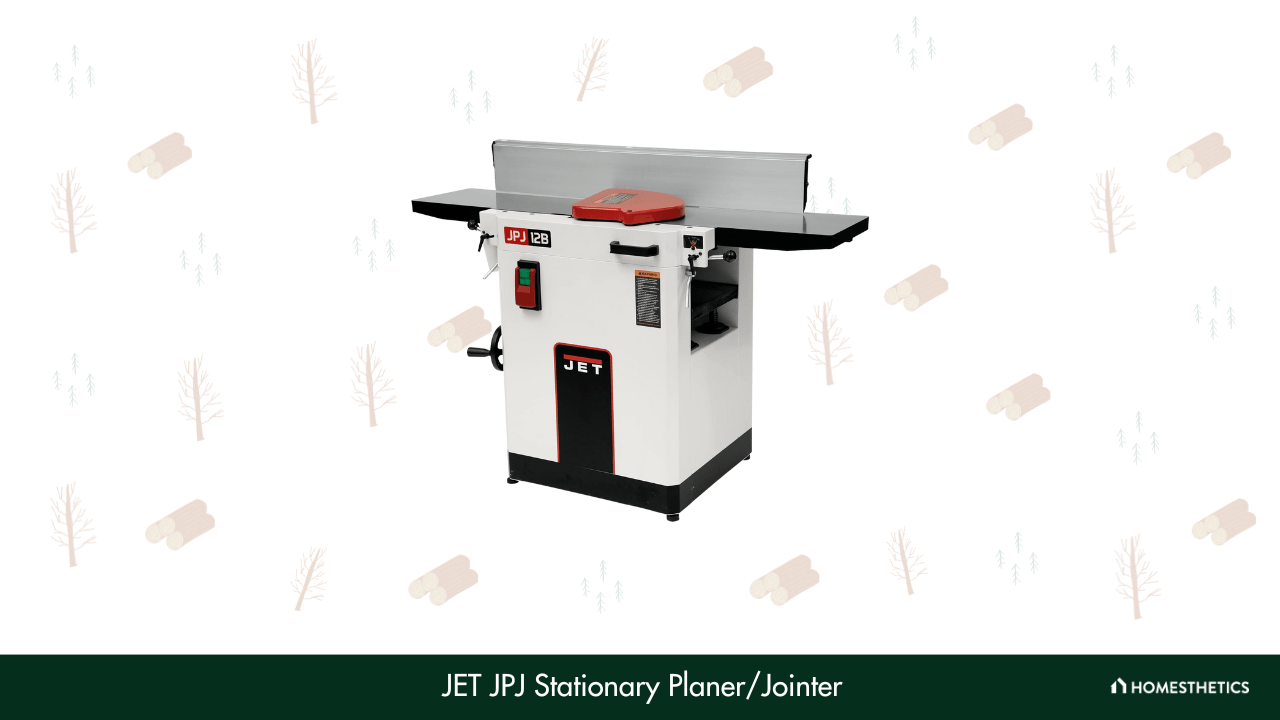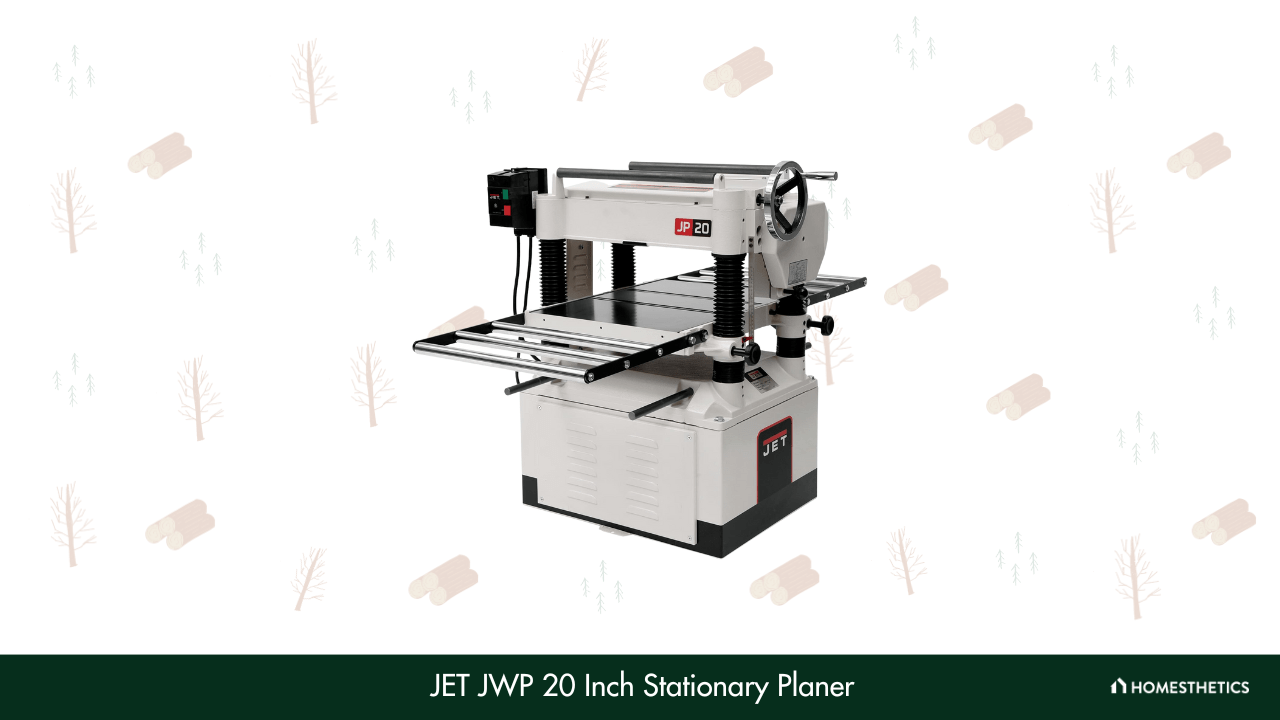Stationary planers are heavy-duty woodworking machines engineered for precision surface flattening and thickness control, key to achieving professional-grade finishes on large timber boards. These powerful tools use a helical or straight-blade cutterhead, driven by industrial-grade motors, to deliver uniform cuts and smooth surfaces across hardwoods and softwoods alike. Designed for workshops and high-volume applications, stationary planers surpass portable models by offering higher throughput, larger cutting widths, and enhanced stability during operation. Among today’s top contenders, the Grizzly Industrial G0890 planer leads with a 15-inch width, dual-feed speeds, and carbide helical cutterheads ideal for dense woods. The JET JWP 15BHH stationary planer follows closely, featuring the brand’s proprietary Precision Air Stabilization System (PASS) for chip control and minimal snipe. Meanwhile, the Powermatic 209HH earns recognition for its whisper-quiet performance and professional accuracy, ideal for furniture makers and advanced DIYers. This curated list of the 7 best stationary planers is based on performance metrics like feed rate, cutterhead type, horsepower, dust collection, and build quality—helping serious woodworkers choose machines that match their shop demands.
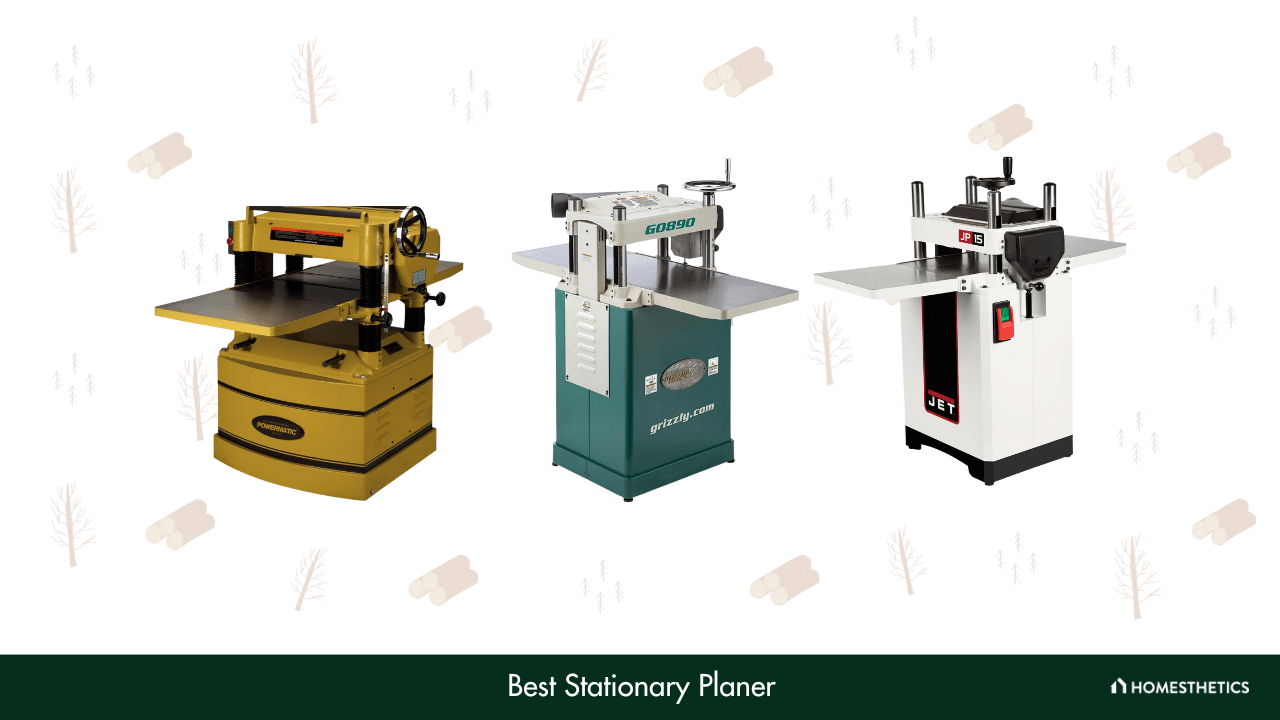
Explore the top-performing stationary planers ideal for your home woodworking projects:
- Grizzly Industrial 15-inch stationary planer: The Grizzly planer stands out as the best overall stationary planer with features like anti-kickback fingers, elevation scale in both inch and metric, high stability, and durability. Its 2-speed gearbox offers versatility, even though it is on the heavier side.
- JET JWP 15-inch stationary planer: The JET JWP planer impresses with a helical cutterhead featuring 48 carbide knives for self-aligning precision. With a 3-horsepower motor and the innovative Precision Air Strut System (PASS), it minimizes snipe and kickback. Dual infeed speed control adds flexibility.
- Powermatic 20-inch stationary planer: The Powermatic planer showcases sturdiness and an expansive working area. Its helical cutterhead with 100 knife inserts ensures smooth and quiet operation. With a 5-horsepower motor and four variable speed options, it handles even the toughest lumber projects.
- Grizzly Industrial 20-inch stationary planer: The Grizzly Industrial G1033X, powered by a robust 5-horsepower motor, offers stability and durability. The large handwheel and rigid pedestal enhance control, and the 5-inch dust chute keeps the workspace clean. The magnetic switch with overload protection adds safety.
- JET JWP straight knives stationary planer: The JET JWP-15B, a budget-friendly option, operates on a 3-horsepower motor with a V-belt transmission for reduced vibration. While using steel blades, it still provides smooth cuts. The PASS technology ensures precision, and the dual infeed speed control maximizes cutting efficiency.
1. Grizzly Industrial 15-inch stationary planer - Best overall
What We Like
- Anti-kickback fingers
- Elevation scale with both inch and metric
- High stability and durability
- 2-speed gearbox
What We Don't Like
- Rather heavy
The Grizzly Industrial G0890 is an industrial wood planer and has a helical cutterhead that can work on most kinds of wood. The oil-bathed 2-speed gearbox has the choice between 16 and 28 FPM, giving out smooth results every single time.
The four heavy-duty support columns, along with a simple handwheel for height adjustment, help to provide stability and durability to the entire woodworking process. Additionally, the cast iron base and fixed height table design together enable a permanent infeed and outfeed roller table setup.
Drawing from experience, all this helps to reduce kickback and sniping and increases the stability of the entire procedure. All in all, this is a pretty great industrial planer to carry out daily production.
2. JET JWP 15-inch stationary planer - Best for helical cutterhead
What We Like
- 2-speed choices
- Included a dust collection system
- Easy depth adjustment
- Precision Air Strut System (PASS)
What We Don't Like
- Cutting depth is not very versatile
You know you can trust JET when it comes to producing excellent woodworking tools. The JET JWP 15BHH stationary thickness planer’s helical cutterhead consists of 48 carbide knives that are engineered to align themselves without any adjustment.
With a 3-horsepower motor and a speed of 5,200 RPM, the planer will be powerful enough for almost all of your lumber projects.
As I experienced it first-hand, one of the best features of this planer is the innovative Precision Air Strut System (PASS), which provides consistent upward pressure on the cutterhead, leading to reduced snipe and kickback.
Additionally, the heavy-duty and precision-ground cast iron table and four-post design allow for maximum control, support, and durability. It even offers dual infeed speed control for either 16 or 20 FPM. So, you get the option of choosing the appropriate speed.
3. Powermatic 20-inch stationary planer - Best for sturdiness
What We Like
- Includes 5-inch dust port
- Four variable speed options
- An expansive working area of 55-1/2 in. x 20 in.
- Easy adjustments
What We Don't Like
- Relatively expensive
The Powermatic 209HH stationary planer works with a helical cutterhead along with four-sided knife inserts, producing extremely smooth (and quiet) results every single time. The 100 knife inserts allow for smooth and effective working.
Working on a 5-horsepower motor, the planer can handle even the hardest pieces of lumber. Additionally, the planer consists of anti-kickback fingers, and pressure bar functions near the cutterhead to produce a sleek finish. Making adjustments is very easy, too, being controlled via a chrome-plated handwheel.
Moreover, the planer comes with a 2-speed oil-bathed gearbox, which transmits full power to feed rollers and facilitates fast speed changes at 24 and 31 FPM. Even more, there is actually an option where you can run the planer at the lower speeds of 16 and 20 FPM.
Apart from all that, giving it a try showed me that the planer is pretty durable and sturdy owing to the cast iron base and four steel columns. The heavy cast iron wings enable a smooth cutting surface for any wood piece.
4. Grizzly Industrial 20-inch stationary planer - Best for motor power
What We Like
- High stability and sturdiness
- Magnetic switch with overload protection
- Includes a 5-inch dust chute
- Powerful motor
What We Don't Like
- Expensive carbide knife replacement
The Grizzly Industrial G1033X stationary thickness planer works using a powerful 5-horsepower motor to produce smooth and even pieces of wood.
The large handwheel makes table movement extremely smooth, and the super rigid pedestal holds the power controls at a convenient height. The extra heavy-duty welded steel base also makes for a very stable and sturdy machine.
Additionally, the planer also comes with a 5-inch dust chute to keep your workspace clean from sawdust and wood debris. The anti-kickback fingers and chip breaker device help to produce smooth results.
Moreover, through my trial and error, I discovered that the bed rollers are very easy to adjust, along with a magnetic switch consisting of overload protection.
5. JET JWP straight knives stationary planer - Best value for money
What We Like
- PASS technology
- Maximum working size of 15 inches wide and 6 inches in height
- Straight knife cutterhead
- Easy adjustments with the handwheel
What We Don't Like
- Uses steel blades which are not as good as carbide blades
The JET JWP-15B stationary planer is a great option if you are on a budget. Working on a 3-horsepower motor, the planer offers a standard cutting depth of ⅛ inches. Due to the V-belt transmission, there is reduced vibration and running noise.
The model comes with a dual infeed speed control for 16 or 20 FPM, which helps to maximize cutting efficiency. Additionally, this planer also includes the PASS technology (Precision Air Strut System). And giving it a try showed me that even though this planer has only 3 knives, it still manages to make the most smooth and efficient cuts.
Moreover, the heavy-duty infeed and outfeed tables provide much-needed support for workpieces and also fold for storage. Along with that, the magnetic switch illuminates whenever powered, enhancing the safety of the machine.
6. JET JPJ stationary planer/jointer - Best for jointer and planer combination
What We Like
- Heavy-duty steel base
- Increased smoothness
- Both planer and jointer functions
- 3 HP motor
What We Don't Like
- Only a two-year commercial warranty
What if I tell you that there is a way you can have a jointer and planer at the same time? The JET JPJ-12B stationary planer/jointer enables easy transmissions between the planer and jointer activities.
This multi-functional machine has a built-in dust chute that can handle both planing and jointing operations, as well as an extra large aluminum fence, whose simple controls allow fast adjustments.
Additionally, my analysis of the product revealed that the 3 HP motor can handle the sturdiest lumber components. It contains three HSS knives which allow for quick cutting and a flawless finish.
Moreover, both the fence and the jointer table assemblies are supported by the heavy-duty, fully welded steel base cabinet, which also houses the engine and the mechanism for the planer table.
7. JET JWP 20-inch stationary planer - Best for consistency
What We Like
- Easy and accurate adjustments
- Heavy-dust cast iron
- Increased stability
- Dust collector
What We Don't Like
- Poor customer service
The JET JWP 208-1 stationary planer has four high-speed steel (HSS) cutterhead blades which help to produce faster cutting. The 3-horsepower motor works with three V-belt transmissions for smoother and more consistent power.
The large handwheel with positive gear drive allows for quick and accurate table adjustments. Additionally, the 1/16-inch increment height scale lets you make fine adjustments. The sets of three infeed and outfeed rollers help to prevent annoying snipes.
Moreover, the heavy-dust cast iron and steel construction keeps the workpiece steady and supported, while the conveniently located 2-speed gearbox with automatic chain tensioner allows for quick and easy feed rate adjustments.
On top of all that, my hands-on review showed that the dust collection is made easy with an exclusive angled 4-inch dust port to keep the hose out of the way.
What are the top stationary planers for your home woodworking projects?
The table below provides a concise yet informative comparison of stationary planers, addressing the needs of home woodworking. It covers essential aspects such as motor power, cutting dimensions, cutterhead type and speed, knife inserts, feed rates, bed length, and dust collection options.
| Stationary Planers | Motor Power | Maximum Cutting Width | Maximum Depth of Cut | Cutterhead Type and Speed | Number of Knives or Carbide Inserts | Feed Rate | Bed Length and Material | Dust Collection |
|---|---|---|---|---|---|---|---|---|
| Grizzly Industrial G0890 | 3 HP | 15" | .125" | Straight knife, 5,200 RPM | 3 | 16, 28 FPM | 49", cast iron | 4" dust port |
| JET JWP-15BHH< | 3 HP | 15" | .125" | Helical, 5,200 RPM | 48 | 16, 20 FPM | 15", cast iron | 4" dust port |
| Powermatic 209HH | 5 HP | 20" | .125" | Helical, 5,000 RPM | 100 | 16, 20, 24, 31 FPM | 25.75", cast iron | Dust chute with 5" port |
| Grizzly Industrial G1033X | 5 HP | 20" | .125" | Helical, 5,000 RPM | 92 | 16, 20 FPM | 56", cast iron | Dust exhaust hood, 5" dust port |
| JET JWP-15B | 3 HP | 15" | .125" | Straight knife, 5,200 RPM | 3 | 16, 20 FPM | 15", cast iron | 4" dust collection port |
| JET JPJ-12B | 3 HP | 12" | .156" | Straight knife, 5,300 RPM | 3 | 16, 26 FPM | 25, cast iron | Built-in dust chute |
| JET JWP-208-1 | 3 HP | 20" | .093" | Straight knife, 5,000 RPM | 4 | 24, 31 FPM | 25.75", cast iron | 5" dust port |
Stationary plane buyer’s guide
A stationary planer is a common tool used in woodworking to smooth out any rough edges, uneven surfaces, or inconsistencies. They are extremely expensive yet needed investments for your wood workshop.
So, to help you choose the right planer for your woodworking needs, here is a buyer’s guide. This consists of all the factors and pointers you need to keep in mind before you go splurging on a stationery planner.
1. Type - Industrial vs. benchtop thickness planers
Industrial-thickness planers are stationary and extremely expensive. They are large in size and take up a lot of space. But at the same time, they are quite worth the price because they can work on the toughest materials without breaking a sweat. This is because of their powerful motors, which usually work between 3 HP and 5 HP.
A benchtop planer, on the other hand, is less expensive and smaller in size. Benchtop planers are portable thickness planers due to their comparatively low weight. Their portability and price is their selling feature. This is why a benchtop thickness planer is great for beginners and woodworkers who are on a budget. This is best for working with softwoods.
Other types of function-specific planers include handheld planers, molding planers, electric planers, etc.
2. Cutting depth
The cutting depth is one of the most important factors to consider before you buy a planer. It should be at least ⅛ inches on each pass. That depth would be satisfactory without removing large pieces of wood at once.
Additionally, apart from the cutting depth, you will also want to focus on how easy it is to adjust that depth. Many planers come with just a simple handwheel to make the depth adjustments. Other planers offer digital means of adjusting, which offer 100% precision. But obviously, the latter would cost more.
So, depending on your woodworking needs and budget, decide the appropriate cutting depth you would require in your planer.
3. Power
Power is another important factor to consider when buying a stationary planer. If you intend to continuously use your planer for demanding wood projects consisting of hardwood, then you should get a planer with a motor of the highest power. The more the power, the easier it is to cut through the material.
All in all, just ensure the planer has a minimum motor power of 3 HP. But of course, a 5 HP motor would be much better and more efficient to use.
4. Feed speed
The feed speed determines how fast any material goes through the planer. The number of choices you will have for the feed speed will depend on the gearbox. Most of the planers have both 16 FPM and 20 FPM as the feed speed options, as you might have noticed in this list.
There are also planers that have the option of 30 FPM. But I recommend you start with the former feed speeds if you are a beginner, since 30 FPM can seem like a little too much to handle for an inexperienced woodworker.
5. Material size
Another factor to consider is what material size your planer can handle before you spend your hard-earned money on it. You have to check out the width, length, and depth of a wood piece that your planer can work with.
Then, according to your woodworking needs and usual working material size, choose the planer that would meet your needs the best. This is why you need to have a thorough understanding of the kind of wood projects you will undertake.
6. Planer and jointer combo machine
A planer and jointer combo machine is an excellent woodworking tool that can act as a power planer and a power jointer whenever you want. This is a good option for those woodworkers who don’t have a lot of space in their woodworking shop to have both a jointer and a planer.
A combo machine might even help to reduce your budget on jointers and planers. However, you will have to continuously switch back and forth between a jointer and a planer.
If you feel the need to buy a planer and jointer combo machine, I suggest you get ones with 16-inch beds or larger. This would enable you to handle any kind of wood project you might undertake.
7. Table support
Large stationary planers have strong cast iron beds and infeed and outfeed tables. Cast iron is needed to provide the required stability and durability the machine needs to deal with thick pieces of lumber. This also means that you can deal with larger pieces of wood.
Benchtop or portable planers, on the other hand, usually are made up of a weaker material, with weak infeed and outfeed tables. These thickness planers cannot handle very thick pieces of lumber. Additionally, this can cause serious snipes on your wood boards.
8. Cutterhead style
Thickness planers usually have two types of cutterheads: straight knives and helical cutterheads (also sometimes known as spiral cutterheads.) Drawing from my experience, helical cutterheads produce much smoother results than straight knives.
The carbide inserts help to maintain a sharper edge, which is also longer than the traditional straight knife planers. A helical cutterhead is also quieter than a straight knife one.
What is a planer?
A planer is an important and efficient woodworking tool that is used to shave wood off the surface of wooden boards. Other tools involved in woodworking are jointers, planers, trim routers, etc.
You can use a planer to make the surface of a wood piece smooth or to reduce its thickness. The different types of planers you can choose from are benchtop planers, electric planers, stationary planers, molding planers, handheld planers, and industrial planers.
What is snipe on my wooden boards?
Snipe on your wooden boards refers to an imprint often seen on the first and last 3-5 inches of a board that has gone through a thickness planer. It occurs when the planer's cutterhead removes too much wood in those areas, typically due to insufficient support from the infeed and outfeed tables. To rectify it, the affected ends may have to be cut off or reprocessed through the planer for correct dimensioning.
Are wood-thickness planers very loud?
Wood-thickness planers are extremely loud. So, I recommend you get some earplugs or hearing protection gear to protect your ears from any damage that might occur while you carry out your woodworking.
Now that we have reached the end of this article, it's time for the verdict:
The Grizzly Industrial secures first place, offering an efficient motor, anti-kickback fingers, and robust cast-iron support for stability and efficiency. Taking second place is the JET JWP 15BHH industrial planer. Its innovative PASS (Precision Air Strut System) technology minimizes sniping and kickback, while the helical cutterhead and 48 carbide inserts ensure smooth and efficient results. In third place, we have the Powermatic stationary planer, featuring 4 feed rate options, 100 knife inserts, and a powerful 5-horsepower motor.
In summary, these are the top stationary planers in the 2023 market, along with essential considerations to guide your purchase decision.

